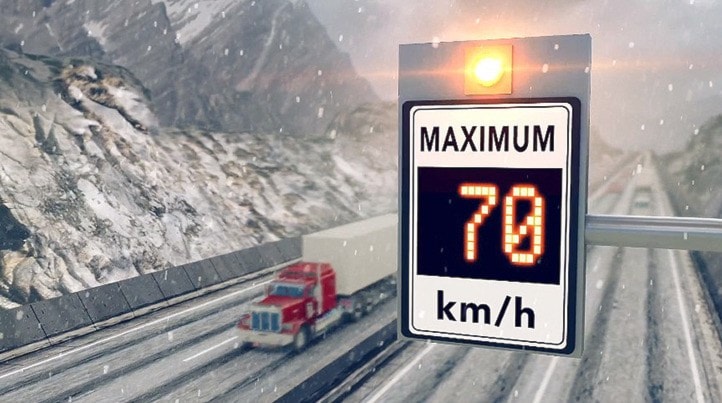A 24-kilometre stretch of the Coquihalla Highway between the Portia Interchange and the former toll plaza has now been equipped with 13 variable speed limit signs, as part of a pilot project from the Ministry of Transportation.
Sections of the Sea-to-Sky Highway north of Squamish, and Highway 1 near Revelstoke, have also been equipped with the signs, which transmit weather and traffic data in real time to the Regional Transportation Management Centre (RTMC) in Coquitlam. The signs require drivers to slow down to match the speed posted, regardless of the regular speed limits on that stretch of highway.
“They’re a driver’s safety partner, taking the guesswork out of determining the safest speed at that particular moment,” says Transportation Minister Todd Stone. Changes made to the Motor Vehicle Act regulations mean that those variable speed limits are the legally enforceable speeds in those areas.
“I want the public to understand that when they see these signs along the roads they are not ‘advisable’ speeds, and not speed reader boards,” says Stone. “These are, or will be, the maximum limits on these highways at that particular time.”
Weather and traffic data will be collected for pavement grip, visibility, temperature, traffic volume, and speed, then transmitted in real time to the RTMC, where a lower speed limit can be authorized by an operator with the appropriate authority to set speed limits. Instructions are then sent to signs in the field to post the new speed limit.
“Whether it’s extremely cold out, freezing rain, or a heavy snowfall, the extensive system of sensors will be calibrated to detect the conditions and make appropriate recommendations for speed limits,” says Stone.
Jordan Sturdy, MLA for West Vancouver-Sea to Sky, says the province will be assessing how successful the project is; and as someone who drives the Sea-to-Sky Highway regularly, he will get a first-hand look at the new signs. “It’s proven successful in other jurisdictions, and we’ll review it after a year and see what the impacts are.” He adds that the system has a variety of different uses.
“One of the great things about this is that it will collect lots of information for us in real time, which we can use to warn drivers about upcoming congestion due to an accident or road maintenance or anything else.”
The LED signs are, he says, hard to miss, so it will be difficult for drivers to get out of a speeding ticket by saying they did not notice them. “When the speed has been changed the signs have flashing LEDs. They’re very visible.”
He notes that there are people on the highways who do not have winter or mountain driving experience. “They’re not necessarily aware that they can start out in sun or rain, that turns into snow or sleet. Conditions are very changeable.” He adds that regular drivers of highways like the Coquihalla also need reminding that the posted speed signs are the maximum recommended speed under ideal conditions. “People sometimes need a reminder that conditions have changed.”
Five new highway webcams have also been installed along the Coquihalla to assist drivers, as well as operators at the RTMC. It is hoped that the new cameras, and the variable speed signs, will spur more drivers to reduce their speed in severe winter conditions and save lives by reducing the frequency and severity of crashes.
It is not just during winter that these new measures will be useful. Stone notes that there was a flash rain and hail event on the Coquihalla recently, and that that is becoming more and more common as part of the changing weather patterns we see around the province. “This technology is geared toward addressing these realities. It is going to save lives in British Columbia.”
